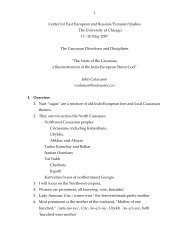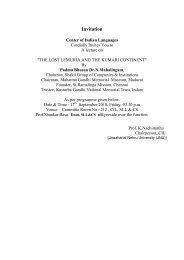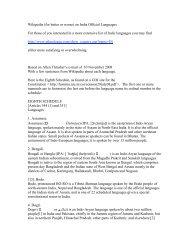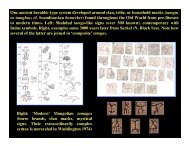Krzysztof Tomasz Witczak: Indoeuropejskie nazwy zbóż ...
Krzysztof Tomasz Witczak: Indoeuropejskie nazwy zbóż ...
Krzysztof Tomasz Witczak: Indoeuropejskie nazwy zbóż ...
Create successful ePaper yourself
Turn your PDF publications into a flip-book with our unique Google optimized e-Paper software.
mention Starostin’s idea (1988, 125) about a substratal origin of this term, based on his comparison with Eastern<br />
Caucasian *sūsV "rye" > Čečen sos, Laq sus id., Axwax šušul "oats" etc.<br />
*sīto-, *sītyo- "corn" (pp. 45) > OI sôt(i)yam n. "corn" (lex.), besides a more frequent meaning "ploughed"<br />
attested by Pāzini | Khowar [not Kati indicated by author] siri "barley", Kalasha šilô "millet" | Mycenaean si-to<br />
"corn; grain (of wheat of barley)", Greek s‹toj "Getreide", especially "Weizen, Brot, Speise", Delphian s‰ton.<br />
According to <strong>Witczak</strong> the preserved s- could be caused by its hypothetical Pelasgian origin.<br />
*spérm‚ : *sporáH2 (p. 119) > Armenian sermn "seed; grain" | Greek spšrma "Same" = Mycenaean pe-mo,<br />
spor£ "Säen, Saat" | Albanian farë "seed; clan" (spórā). Derived from the verb *sper- (LIV 580) attested e.g. in<br />
Armenian sermanel "to sow", Greek spe…rw "to sow; produce, beget, give birth".<br />
*(s)pCt- "Triticum spelta" (pp. 100) > Greek pÒltoj "Brei aus Mehl" | Latin puls, pultis f. "eine Spelzgrütze",<br />
Old Italian polta "Brühe, Brei" > Old High German polz id.; late Latin spelta occurs first in the edict of<br />
Diocletian AD 301; according to witness of Saint Hieronym it is of Pannonian origin.<br />
*swaH2raH2 "common millet" (pp. 79-81) > Iranian hwārā- > Alan huvar "millet", Ossetic Digor xwar "corn,<br />
grain, millet", Iron xor "corn, barley Hordeum vulgare", Sogdian γwr- "barley", Middle Persian xwār "food" |<br />
?Albanian egjër "Lolium termulentum" < *‚-s(w)ārā = "non-millet" after Jokl (Wörter und Sachen 12, 1929,<br />
78-79) | Lithuanian sóra, pl. sóros "millet", Latvian sâre, dial. sûra "Rispenhirse" | Tocharian AB sāry- "to<br />
plant", sārm "seed"; the n-derivative is common for Iranian and Baltic: Avestan x v arəna-(not xv v arəna-)<br />
"Nahrung"; cf. the borrowing in Slavic *chorna "food" | Lithuanian svirna f., svi9nas m. "Speicher,<br />
Vorratskammer". The author admits the v3ddhi-formation from the root *swer- > Iranian *x v ar- "to nourish;<br />
defend". But he prefers the Nostratic origin, referring to such forms as Semitic *fu C ār-(at-) "barley" (lit. "hairy")<br />
and Uralic *śōra.<br />
*wesH2aros "spring corn" (pp. 42-43) > Armenian gari, gen. gareoy "barley" | Welsh wenith, Breton gwiniz<br />
"wheat" | Tocharian A wsār "heap of grain", B ysāre "grain; ?wheat"; from the word for "spring" reconstructible<br />
as *wesH3, gen. *wesH2nos, cf. Lithuanian vasar¿niai kviečiaĩ & rugiaĩ "spring wheat & rye", etc.<br />
*yéwH1os, -om "barley" > "corn" (pp. 43-44) > OI yáva- m. "barley" | Avestan yauua- m. "Getreide", yauua—ha-<br />
n. "Weide"; Ossetic yäw "millet" | Hittite ewan n. "barley" | Greek zeia… "Triticum monococcum", Cretan dha…<br />
"barley; Hordeum" | Old Irish éorna "barley" | Lithuanian jãvas "Getreideart", pl. javaĩ "Getreide" | Earlier<br />
Russian jevin, Russian ovin "Getreidedarre, Riege" | Tocharian B yap "millet" < *yewH1om.<br />
Comments to the additional comparative material:<br />
P. 46 - Slavic *žito "corn, cereal", especially "wheat, rye" | Old Prussian geits & geitko "bread" | Welsh bwyd<br />
"food", Old Cornish buit, Breton boed; Old Irish biad. Add Hittite kuuitta- "a kind of a bread" (Van Windekens,<br />
Archiv orientální 57, 1989, 334-35; Puhvel, HED IV, 1997, 315).<br />
P. 59 - Slavic *ęčь-my "barley" - following Charpentier (1907, 464), it is possible to connect it with Greek<br />
Ômp(n)h "Nahrung, Getreide". Starostin (1988, 127) proposed a substratal origin of *Henk w -/*Honk w -, seeking a<br />
support in North Caucasian *#əIm%%wV "barley", reconstructed on the basis of Avar o%, Bežit õX id., Axwax<br />
ũqa "oats", Ubykh Xwa "barley", etc. But later Nikolajev & Starostin (1994, 502-503) changed their<br />
reconstruction in *ħn\rqwÌ, regarding Tabasaran nurχI "spelt", Agul nir`X "ground wheat".<br />
P. 63 - Tocharian klu "rice" is derivable from an Old Chinese source of the type *lhū’ ~ *łhū’ "growing rice,<br />
paddy" (Blažek 1999, 82).<br />
P. 106 - Old High German dinchel, thincil, dinkil "Dinkel, Triticum spelta", with the variants tünkel, tunkel from<br />
modern dialects, is compatible with Anatolian data: Hittite (NINDA) tuni(n)k- "a bread", Hieroglyphic Luwian<br />
tunikala "maker of tunik-bread", with the suffix -ala- of nomina agentis (Tischler III, Lief. 10, 1994, 438-39).<br />
P. 106 - Kartvelian *di"a- "wheat" has the closest parallel (source?) in North Caucasian *dī"wi "a kind of cereal"<br />
(Nikolajev & Starostin 1994, 400).<br />
P. 106 - For Hittite seppitt- (& sappitt-) "wheat" there are two possible internal etymologies, based on<br />
comparison with (i) sepa- "Garbe; Getreidebündel"; (ii) sappisarahh- "to make into a cleansed person". In the<br />
first case it is necessary to explain the difference between -p- and -pp-. But cf. two verbs with similar semantics,<br />
viz. sapiya- "to scrub, rub" vs. sappai-/sippai- "to peel, trim; scrape". In the second case the semantic motivation<br />
"wheat" = "cleared" is known from Semitic languages, cf. Akkadian burru "sorte de céréale", Hebrew bar<br />
"céréale, blé battu", Arabic burr, Sabaic br, Soqotri bor, Mehri barr "froment, blé" vs. Akkadian barru "pur",<br />
Ugaritic brr id., Hebrew bārar "purifier", Aramaic b e rar id., Minaean š-brr id. (Cohen 1976, 87). On the other<br />
hand, both the verbs sapiya- "to scrub, rub" vs. sappai-/sippai- "to peel, trim; scrape" stand in semantics not too<br />
far.<br />
Summing up, <strong>Witczak</strong>’s book represents the most detailed study devoted to the Indo-European cereal<br />
terminology. The author has convincingly demonstrated the agricultural past of the Indo-Europeans. Some of the<br />
designations of cereals were probably inherited from the preceding, namely Nostratic, period. Others, with








